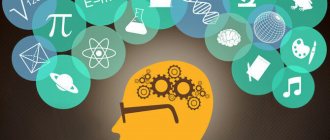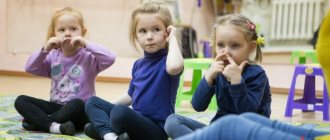Mnemonics for beginners is a system of various methods that helps to remember information using various associations and is used in teaching children from preschool age. This technique uses previously acquired knowledge to create a chain of connections. Thanks to such logical series, you can easily remember information that is difficult to perceive.
There are many mnemonic techniques. For example, Cicero’s method is based on spatial imagination, while Aivazovsky’s method works by training visual memory. Number sequences, foreign words or complex terms are easier to remember with the help of consonant or familiar words and numbers.
In a time when there was no written language, ancient priests and storytellers had to memorize enormous amounts of information. With the advent of the first texts put on paper, the art of using mnemonics did not lose its relevance, because the raw materials for writing them were very expensive. Even in Ancient Greece, notes were made using mnemonics. The art of associative memorization was mastered by the monks of the Middle Ages. At all times, people who could quickly remember and store useful and interesting knowledge in their heads were valued.
Pros and cons of mnemonics
Mnemonics are actively used in teaching children. For example, one of the most famous phrases for studying the sequence in the color spectrum is “Every Hunter Wants to Know Where the Pheasant Sits.” It is she who helps to accurately tell how a rainbow “works.”
The role of methodology in the development of children:
- helps you remember information quickly and for a long time;
- improves memory and attentiveness;
- develops speech, expands vocabulary and horizons, teaches how to pronounce sounds and words correctly;
- forms logical and imaginative thinking;
- improves imagination, intellectual and creative abilities;
- develops character, teaches sociability, helps to overcome isolation and shyness.
When used correctly, mnemonics have very few disadvantages.
- At the initial stage of use, children have a small vocabulary, so it can be difficult for them to work using this method.
- There is no need to abuse the method and use it in cases where it is too easy to understand the properties and remember the signs - this hinders the child’s development.
- Sometimes it is not possible to use the technique. For all-round development, it is necessary to teach the child to learn information mechanically; this skill will also be useful in the future.
The human brain consists of two hemispheres. The left is responsible for logic and speech, and the right helps to perceive different colors and form images using the imagination. When using mnemonic techniques, both halves are activated simultaneously. As a result, thought processes bring maximum benefit in the form of acquired knowledge.
Mnemonic tables on speech development for older preschoolers
Correctly developed schemes are effective, not cumbersome, and resemble a game.
Speech Problems That Can Be Resolved Using Graphic Charts
Mnemonics solve speech problems:
- Difficulties in diction (including difficulty pronouncing sounds).
- Inability to control the voice (intonation, tempo, volume).
- Inability to build a dialogue (formulation of questions, detailed or short answers).
- Monosyllabic speech (includes only simple sentences).
- Insufficient vocabulary.
- Use of non-literary vocabulary.
- Difficulties during the construction of a monologue (retelling, descriptive or plot story on a specified topic).
- Inability to substantiate conclusions and conclusions.
Thanks to the technique, the following mental and thought processes are improved, on which correct speech depends:
- memory;
- imagination;
- attention;
- observation;
- ability to compare and highlight key elements.
The essence of mnemonics
Mnemonics are used to develop the ability to remember, recreate information, and strengthen memory. The student perceives the material and reproduces it from the images. The essence of the technique: the baby develops associations between a word (phrase) and a picture. Next, the word is associated with a number of association pictures.
Important! Instead of drawings, symbols are suitable for adult preschoolers.
After mastering the method, the child is able to convey words (texts) schematically and decipher signs. Used by teachers, including speech therapists. This makes it easier to absorb knowledge. Tables are especially valuable when memorizing poetry, retelling texts, and solving logical problems. This is one of the basic techniques for the development of children in the DAO.
Advantages of technology
Mnemonic tables are attention-grabbing symbols and drawings that correspond to the mental characteristics of children (distracted attention, visual-figurative thinking). Advantages of the technique:
Colorful drawings are replaced by graphic symbols
- visualization of logical chains;
- emphasis on the essentials (main steps, historical moments, characteristics);
- availability of parts (for detailed descriptions);
- brightness, capacity, conciseness, holding attention;
- development of creativity, communication, associative thinking, speech.
Admission is in demand not only in DAO, but also in classes with students of any age.
Important! The gradual complication of tables and their diversity broadens one's horizons, improves imagination, and helps to systematize accumulated intellectual baggage.
Independent production of mnemonic tables
The material is purchased and created independently. It is worth taking Tkachenko T.A.’s schemes as a basis. or Vorobyova V.K. They are used as a starting point in creativity or modified, taking into account the individuality of the students. Stages of circuit development:
- Illustrations are selected for the word (draw, find ready-made ones). Bright, detailed pictures will suit kids.
- If the guys remember the drawing, it is replaced with a graphic symbol. For example, a bird is a tick, a squirrel is a brown circle.
- When retelling short works, children are guided by such schemes. These can be drawings, images and symbols, only symbols.
Speech therapy exercises for speech development in children from 3 to 4 years old
Didactic materials—illustrations—are indispensable when learning about colors, shapes, textures, and sizes. Separate pictures indicate parts of the encrypted item, areas of application, permitted and prohibited actions with it. Lessons with mnemonic tables begin with looking at pictures and talking (kids ask, guess, analyze).
Methods of cognition using charts-tables
It is important to use the manual correctly in order to develop the necessary skills in children. Sequence of work:
- Examination of bright pictures indicating phrases and words.
- They study a more complex structure - mnemonic tracks (up to 4 consecutive, logically connected pictures). On their basis, the children compose short texts.
- Stage of formation of coherent texts. Thanks to pictures with actions (walking, swimming), verb vocabulary is learned. The emphasis is on the stages of action and their results.
While improving their speech, children try to notice important nuances of images without departing from the essence of the story.
Mnemonic tracks and tables fuel interest in studying the world, hold attention, and help find connections between objects.
Important! These visual diagrams are useful when studying literature, mathematics, nature and other subjects.
From what age is it used?
Teaching children using mnemonics can begin from a very early age. Getting to know exercises for children starts with simple techniques.
First, they use mnemonic squares, which can be introduced to children at the age of three. In the first lessons, children study simple images that represent one word, phrase or simple phrase. You can place pictures in a square and learn poems with movements.
Later, at 4-5 years old, children become familiar with mnemonic tracks - systematized pictures of four drawings. With the help of such images, the concept of sequences is formed. Thanks to group illustrations, you can easily tell a short story, remember the steps of washing your hands, the process of dressing or washing your face.
Children aged 6-7 years begin to study mnemonic tables that allow them to perform more complex actions:
- retell various works;
- memorize poems and complex words;
- guess and make riddles;
- find rhymes for words;
- invent fairy tales or stories;
- distribute objects into groups according to certain characteristics;
- study numbers;
- become familiar with the basic rules of life safety and behavior in various places, and methods of self-service.
Children learn to express their thoughts correctly and beautifully and use new words in speech. Attention and intelligence develop, the ability to highlight the main thing and compare improves.
Development of fantasy
In preschool educational institutions (DOU), mnemonic tables can be used to develop thinking and imagination. You should start with simple signs that depict objects denoted by one word or phrase. There are 4 signs in total. Then the task becomes more complicated. The teacher should arrange the cards in the form of a square. Following the path of the square, children must compose a short story of two or three sentences. At first, you can ask children leading questions. Then we can offer mnemonic tables with the help of which a whole story is compiled. Also, using these tables you can simplify the task of memorizing a story or poem.
At first, the teacher compiles mnemonic tables. When children have sufficiently grasped the essence of mnemonics, they can begin to be introduced to the process of creating tables.
Features of application
You can achieve results during mnemonics classes if you follow the basic rules for using the technique.
- Subsequence. You cannot start classes with difficult tasks. First they work with mnemonic squares, single images, then with mnemonic tracks and mnemonic tables.
- Rationing. Children are not shown more than two tables per day, and the number of images in each block should be no more than 9 pieces. Too much information is difficult for a child to absorb, so classes will be ineffective.
- Colorfulness. The pictures should interest the child in their appearance. They use bright colors, rich and expressive images. Tables in black and white will not be able to attract the attention of children and have the desired impact; they can only be used for children of older preschool age.
- Emotionality. Children should feel the positive energy of such activities.
- Diversity. Pictures or series of images for one lesson should be on different topics. Guys will quickly lose interest in the same type of training. It is also advisable to select tables that require different actions. For example, the first pictures help to remember the sequence of food intake, and the next group helps to tell about how insects move.
- No coercive measures: just a game. Classes can only be conducted when children are involved in the process with pleasure and interest. Everything should happen in a playful way. If the children's attention wanes, it is better to stop the lesson and continue at another time.
It is enough to adhere to these simple principles to achieve maximum learning results.
Mnemonics for children: tables of numbers, letters, symbols
The simplest method for allowing a child to remember numbers, letters and symbols is a table. You can draw such tables yourself using our tips.
In order to remember numbers, make diagrams by placing numbers and associations to them. Example:
| 1 | Stake, spear, pen, stick |
| 2 | Swan, duck, lantern |
| 4 | Chair, armchair |
| 7 | Hatchet |
To memorize letters, make a similar diagram, only the essence here is slightly different. Place the letters in the first column, and in the second, draw images whose names begin with this letter.
| A | Watermelon, Pineapple, Stork |
| IN | Wolf, Grapes |
| G | Pear, Mushroom |
| M | Raspberries |
| WITH | Sun, Dog |
Historical examples of phenomenal abilities
Vivid examples in history who had a brilliant ability to remember were Julius Caesar and Alexander the Great, who knew about 30,000 of all their soldiers by name and face.
The great Mozart, having once heard the polyphonic spiritual composition “Allegri” in the Vatican, wrote down exactly the same copy of the work overnight, note for note! But Themistocles knew every inhabitant of Athens by name. And there were at least 20 thousand of them. And modernity can boast of possessing unique memories.
For example, Kim Peek, the prototype of the main character of the film “Rain Man,” had a unique memory. He could remember up to 98% of all information he read. Moreover, Kim could simultaneously read the right page with his right eye and the left page of a book spread with his left eye. But the unique chess players Paul Morphy and Paul Sens could play several games at once and store in their memory all the past and upcoming moves of each.
A simple operator in Tasmania working in a help desk can recite more than 128 thousand telephone numbers and exact addresses of subscribers by heart.
But work on memorization is based on a simple technique - this is associating an object with an image, emotions, sounds and even smells or taste characteristics. Children perceive all this especially acutely. Their memorization works unconsciously; they absorb everything that they saw or heard somewhere. And the puzzled parents then rack their brains: “Where could my baby have picked up such a thing? After all, at home everything is completely different with us.” Therefore, such a feature of perception should be turned, as they say, in a direction that is convenient and necessary for you and me!
Visualization techniques
When memorizing poems, each line is depicted with pictures.
Mnemonics techniques are based on the use of certain types of memorization . Of course, the most effective way to use any technology for raising and developing a child is through play. And mnemonics in this sense are a real storehouse of ideas.
- "Get a group together." The child is given separate pictures (for example, symbols of the seasons, clothes, types of activities) - he needs to group the pictures and explain why they are together.
- “Draw your impressions.” This technique perfectly expands the baby's vocabulary. And, by the way, it forms family traditions. Invite your little one to sketch their impressions of the day together, so that later they can tell what was good and bad about it. Each time, try to add one or more concepts and words that are new to your child.
- "Learn a poem." To make it easier to memorize poems, use visual tables in which each line is presented in the form of a picture or symbol. Try to always supplement the image with a word (if the baby can read) or a letter (if the child has not yet mastered this skill).
- "Memory Grid". Show your child the pictures, say what they are and turn them over. The child’s task is to name the depicted object, and then test himself by opening the mnemonic picture.
- "Stories with pictures." On the Internet you can find a lot of children's stories in which words are partially replaced by pictures. This way, the baby not only learns new words, but also develops the ability to focus on reading.
- "Photo memory". Show the child a picture, then remove it and give in return another one that differs from the first in some detail. For example, the first one shows a girl with a red bow, and the second one shows the same girl, but the bow is blue.
- "Day Night". Place a series of pictures in front of your child. Then say, “Night has come.” The baby covers his eyes with his hands, and at this time you hide one picture. The child’s task is to guess what is missing.
There are several methods of working with children over one year old whose speech is just beginning to develop.
- Tactile games. This mnemonic technique is intended for the smallest toddlers who do not yet speak. Its essence lies in the fact that pictures are replaced with objects. For example, to get acquainted with different round objects, put a pebble of a suitable shape, a tennis ball, a cap from a bottle or tube of cream, etc. in a bag. Ask your baby to take this or that object out of the bag by touch.
- Sound lotto. Play sounds for your child to match the pictures to. For example, “Who talks like this”: listen to the meow of a cat, the roar of a lion and ask the child to show a picture of the animal.
- Flannelograph. Cover the magnetic board with fabric and purchase a set of pictures with magnets (you can make them yourself by gluing a magnet to the back of the image). Tell your baby stories, pausing at certain parts. The little one’s task is to choose a suitable picture depicting the object you settled on and attach it to the flannelgraph.
Rules for using mnemonic techniques
You both need to be in the right mood to work with your baby.
As you know, children quickly lose interest in one activity or another. But mnemonics requires regular practice. Therefore, try to adhere to the following rules so that your baby does not get bored:
- offer to play only when the child is not hungry and does not want to sleep;
- do not interrupt the little one if he is already busy with something - it is better to wait for a more convenient opportunity;
- make classes traditional, preferably at the same time;
- do not rush the child, give him time to comprehend the task;
- help find a solution if you see that your child has stalled or is going in the wrong direction.
Mnemonics in kindergarten based on fairy tales: methods for preschool teachers
You can train children’s memory and teach them to retell some texts on a variety of topics even in kindergartens. For this type of mnemonics, teachers, as a rule, use reference diagrams. Learning begins at the age of 1 or 2, when the child is already familiar with some fairy tales and tries to tell them, confusing characters and events. Special mnemonic tables for preschool children are compiled by teachers based on fairy tales known to them.
The images in the table cells are fairy tale characters. A fairy tale called “Kolobok” is quite convenient for such practice. In this table, events are repeated from time to time, and characters change. For children 2 years old, tables consisting of 4 – 9 cells, no more, are suitable.
The following tables are drawn by the teacher and the children. The children will take part in the compilation of such mnemonic tables with great pleasure. In the future, they will independently come up with tables for any fairy tale, complicating them a little, increasing the number of cells themselves.
Memory improvement in this case occurs due to the regular encoding of verbal information into pictures and vice versa. As a result, children scroll through the received material in their heads several times, memorizing it automatically.
For children over 5 years old the task becomes a little more complicated:
- Option 1. The table includes characters from completely different fairy tales. Then the children determine which characters in the table are superfluous.
- Option 2. Fairy tale characters are mixed in the table. Children must distribute these heroes into the correct tables.
- Option 3. The tables are cut, then the children restore them themselves. The cards are scattered, the teacher reads a fairy tale, and the children find the necessary image.
The use of mnemonics in speech therapy sessions with children
Preschool age is considered the most favorable, since during this period of a child’s life the foundations of literacy, clear pronunciation of words, and beautiful speech are laid. These are very important conditions that influence the mental education of a child. A child with speech impairment has the following problems:
- Minimum set of words.
- Inability to form sentences from words.
- Impaired pronunciation of certain sounds.
- Disturbed attention.
- Broken logic.
When faced with such a problem, you can use mnemonics. Thanks to it you will achieve the following results:
- The child’s connected speech and associative thinking will improve.
- The child will be able to better assimilate the material using visual and auditory memory.
- The child’s imagination will work better and the process of memorizing sounds will speed up.
Mnemonic squares are an ideal method, a symbol of any successful lesson. Thanks to such schemes, you will quickly teach your child to learn poems, riddles, and tongue twisters.
Mnemonics in the classroom
The stages of study are:
- Read the poem expressively to your child.
- Ask your child to learn the verse with you.
- Read the poem again, focusing on the mnemonic table.
- Ask your child questions about the verse. Help him if necessary, clarify with him the main idea of the work.
- Find out from your child exactly which words seemed incomprehensible to him. Explain what they mean.
- Read each line of the verse separately. Ask your child to repeat the verse.
- At the very end, the child will have to recite a poem.
In the mnemonic table that you will use, enter all the characters in the verse. Thanks to this, your baby will learn to concentrate, construct sentences correctly and express his own speech.
The earlier the better
I, of course, do not want to say that all of the above examples of human capabilities became famous only thanks to mnemonic exercises, but, nevertheless, the use of these seemingly simple associative cards with pictures should begin to be used according to the principle, the sooner the better! Moreover, in addition to the memorization process, they help the child:
develop imagination,
improve attentiveness and perseverance,
develop logical thinking,
for speech development,
perceive information in a simple, interesting and unobtrusive form.
And so let's sum up the first result, mnemonics is a kind of art of memorization, a technology that, by the way, got its name thanks to the ancient Greek patroness of memory Mnemosyne, connecting information with visual images. Accordingly, mnemonics involves the use of images on cards, in books, drawn on paper or in electronic form. Even the well-known alphabet with pictures is a clear example of mnemonics. Remember when you were a child, because the above book aroused interest only thanks to the colorful illustrations. Kids themselves don’t understand that when they look at the pictures in the alphabet, they automatically memorize the alphabet!
What about the usual pictures on children's lockers? Yes, yes - this is also a mnemonic technique used within the walls of kindergartens a long time ago. The kid remembers that it is on his locker that a car, doll, ball or bunny is drawn and over time he automatically finds things on his own, without the help of adults.
Not only teachers of children's educational institutions, but also parents should be involved in working with mnemonics. And then, perhaps, it will be your child who will join the list of owners of a unique memory.
To get started with developmental activities, use ready-made teaching materials. And I will be happy to bring those that help me!
Mnemonics for learning vocabulary words: techniques, word associations
To study vocabulary words, the following types of mnemonics are used:
- Visual associations.
- Sound associations.
- Mnemonics of “connections” and many others.
Children like visual associations the most. While memorizing a certain word, invite your child to look at a picture that will represent the word, plus he will be able to play with a letter that is difficult to remember. For example, draw the word “Magnet” and the letter “A” in the picture. When choosing other words, focus on those letters that your baby cannot say or write.
Also, in other words, depict the letters that cause difficulties for the child while writing with pictures, taking into account the meaning of the word itself. In the word “Kopeyka” the second letter is very similar to a penny. Therefore, draw her instead.
The next technique is sound associations. For example, the word “Breakfast” is similar to the word “Cancer”. By combining these words into one single phrase, you can get the sentence: “ There will be boiled crayfish breakfast .” Your child will learn this word using sound association. And the phrase itself sounds more melodic, therefore, it is remembered without problems.










